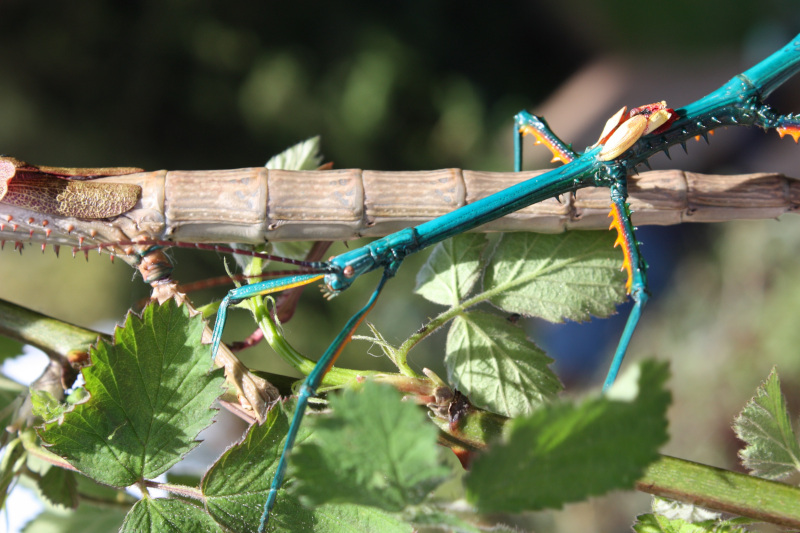
Achrioptera manga Facts
- First of all, the amazing invertebrate known as the Achrioptera manga has no common name as of this time. This occurs due to the fact that the fascinating invertebrate represents a completely newly recognized species. Furthermore, scientists first collected specimens of the truly stunning creature as early as the year 2007. However, at that time scientists misidentified it as a member of another, visually similar species.
- In addition, this species, along with another recently identified one, remains collectively referred to as Malagasy Giant Stick Insects. The other, closely related species, remains quite similar in terms of physical appearance. Both species, in the genus Achrioptera, share a trait highly unusual among stick insects. That’s because very few stick insects display bright colors, usually showing colors that provide protective camouflage.
- At this time, the IUCN has no listing for this remarkable insect. This holds true simply due to a lack of sufficient information about the species. However, given its limited territorial range, further evaluation may determine a status reflective of a species in danger. It also faces other potential threats to its existence. Like many species, especially those with restricted ranges, these include climate change and habitat loss.
Related Articles
Achrioptera manga Physical Description
Firstly, the stunning Achrioptera manga represents an especially large variety of stick insect. Secondly, however, much like many other invertebrates, this species displays a marked degree of sexual dimorphism. In its case, the females attain a significantly larger size than their male counterparts.
This holds true due to the fact that the highly robust females reach an average body length of roughly 7.9 -9.1 in (20 – 23 cm). Meanwhile, the males only grow to about 5.2 – 5.7 in (13 – 14.5 cm). Furthermore, the shorter males also display a significantly slimmer body structure than the females.
Yet, both genders display a number of sharp spines on the legs and thorax. However, the males typically also possess these spines on the head, while among females these occur only sporadically. In addition, both genders of this species display bright red hindwings. Both also have rather small eyes, compared to related creatures.
But the arthropod also displays another quite striking example of sexual dimorphism, as well. This occurs in the way of natural coloring. The females present a mostly light to dark brown, with only a few spots of bright colors. Yet the male displays a bright turquoise blue color over much of its body, in addition to the patches of other colors elsewhere.
- Kingdom: Animalia
- Phylum: Arthropoda
- Class: Insecta
- Order: Phasmatodea
- Family: Phasmatidae
- Genus: Achrioptera
- Species: A. manga
Achrioptera manga Distribution, Habitat, and Ecology
Quite regrettably, but not at all surprisingly, the gorgeous Achrioptera manga has an extremely limited habitat range. This holds true because of the fact that, to date, its only known habitat consists of a single forest. Furthermore, this lone location also sits in an especially remote section of the island country of Madagascar, located quite near Africa.
Both genders of this arthropod remain primarily active during the day, including the newly hatched nymphs. However, for reasons that currently remain undetermined, this holds especially true for adult males. Additionally, individuals tend to move about far more frequently during windy periods. The reason for this also remains undetermined at this time.
Like other known types of stick insect, the Achrioptera manga has an entirely herbivorous diet. In its case, adults and nymphs alike feed on a wide variety of local plants. But, certain varieties appear to be preferred. This primarily includes salal, bramble, eucalyptus, oak, and raspberry. In yet another minor mystery, adult females appear to prefer drier foliage to fresh.
The insect also displays yet another deviation from patterns normal for stick insects. In this species, mating occur frequently, and at anytime of the year. But, after mating, the male remains with the female for no more than a few days. Following the laying of the eggs, the female actually throws the eggs from her, into the surrounding foliage. Incubation lasts 4 – 5 months, while adults rarely live more than a few months.
Species Sharing Its Range
Check out our other articles on 4 Fantastically Fascinating Fungi, Mary River Turtle, Belogradchik Rocks, Naked Man Orchid, Snowy Owl, Palos verdes blue, Purple Frog, Australian Sea Lion
